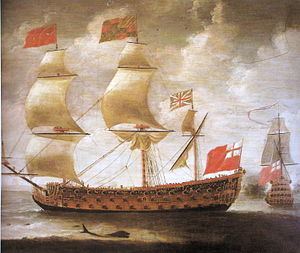Name Prince Royal Laid down 20 October 1608 Launched 25 July 1610 | Ordered November 1607 Construction started 20 October 1608 Designer Peter Pett | |
 | ||
Notes Participated inBattle of the Kentish KnockBattle of the GabbardBattle of ScheveningenBattle of LowestoftFour Days Battle | ||
Prince Royal was a 55-gun royal ship of the English Royal Navy, built by Phineas Pett I at Woolwich and launched in 1610. The ship fittings were carved by Sebastian Vicars, and painted and gilded by Robert Peake and Paul Isackson between Easter and Michaelmas 1611.
She was the first ship of the line with three complete gun decks, although when first completed the upper deck carried no guns in the waist, and was stepped down aft because of the large amount of sheer (the manner in which the decks rose towards the stern and bow). In 1621 a refit saw the removal of this step-down, with all three gun decks now being continuous.
From 1639 to 1641 she was rebuilt by Peter Pett at Woolwich as a 70-gun first-rate ship. During the time of the Commonwealth of England, she was named Resolution and fought in most battles of the First Anglo-Dutch War. By 1660 she was carrying 80 guns, and with the English Restoration of King Charles II she resumed the name Royal Prince. In 1663 she was rebuilt again at Woolwich Dockyard by Sir Phineas Pett II as a 92-gun first-rate ship of the line.
In 1665, during the Second Anglo-Dutch War, she served as flagship of Edward Montagu, 1st Earl of Sandwich at the Battle of Lowestoft on 3 June. A year later in 1666, she was Vice-Admiral George Ayscue's flagship in the Four Days Battle, on the third day of which (3 June by the Julian calendar then used in England) she ran aground on the Galloper Sand. When Dutch fireships surrounded the stranded ship, the crew panicked and Ayscue was forced to surrender to Lieutenant-Admiral Cornelis Tromp who was aboard the Gouda. The Dutch managed to free the ship from the shoal, but found her steering to be irreparably damaged. In accordance with standing orders by the States-General of the Netherlands, Lieutenant-Admiral Michiel de Ruyter ordered the Prince Royal to be burned to prevent her being recaptured.
